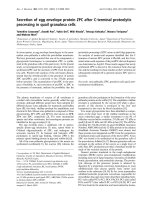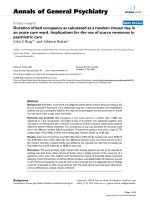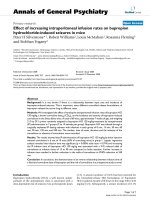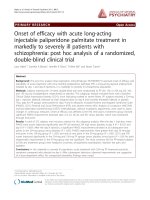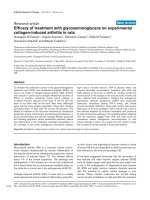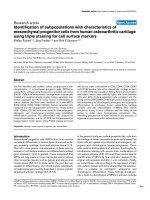Báo cáo y học: " Onset of relief of dyspnoea with budesonide/formoterol or salbutamol following methacholine-induced severe bronchoconstriction in adults with asthma: a double-blind, placebo-controlled study" pptx
Bạn đang xem bản rút gọn của tài liệu. Xem và tải ngay bản đầy đủ của tài liệu tại đây (428.1 KB, 10 trang )
BioMed Central
Page 1 of 10
(page number not for citation purposes)
Respiratory Research
Open Access
Research
Onset of relief of dyspnoea with budesonide/formoterol or
salbutamol following methacholine-induced severe
bronchoconstriction in adults with asthma: a double-blind,
placebo-controlled study
René E Jonkers*
1
, Theo A Bantje
2
and René Aalbers
3
Address:
1
Department of Pulmonary Diseases, Academic Medical Centre, Amsterdam, The Netherlands,
2
Department of Pulmonary Diseases,
Amphia Ziekenhuis, Breda, The Netherlands and
3
Department of Pulmonary Diseases, Martini Hospital, Groningen, The Netherlands
Email: RenéEJonkers*; Theo A Bantje - ; René Aalbers -
* Corresponding author
Abstract
Background: The long-acting β
2
-agonist (LABA) formoterol has an onset of effect comparable to that of
salbutamol. Consequently, the combination of formoterol and budesonide in one inhaler, approved for
maintenance use, can potentially be used for reliever therapy. This study compared the onset of relief from
induced bronchospasm with a single dose of budesonide/formoterol versus standard salbutamol therapy
in patients with asthma.
Methods: In this randomised, double-blind, placebo-controlled, cross-over study, 32 patients with asthma
underwent a methacholine provocation test leading to a fall in forced expiratory volume in 1 second (FEV
1
)
of ≥30% at enrolment (Visit 1) and three subsequent study visits (Visits 2–4). Immediately after each
provocation at Visits 2–4, patients received one of three test treatments: one inhalation of budesonide/
formoterol 160/4.5 µg (via Turbuhaler
®
), two inhalations of salbutamol 100 µg (via a pressurised metered-
dose inhaler [pMDI]) or placebo. All patients received each of the test treatments in a randomised order,
after separate methacholine provocations. The effect of treatment on FEV
1
and breathlessness (using the
Borg scale) was measured at 1, 3, 5, 10, 15, 20, 25 and 30 minutes after test treatment.
Results: Following methacholine provocation, Borg score increased from a baseline value of below 0.5 to
3.03, 3.31 and 3.50 before treatment with budesonide/formoterol, salbutamol and placebo, respectively.
Budesonide/formoterol and salbutamol reversed methacholine-induced dyspnoea (breathlessness) rapidly.
At 1 minute after inhalation, statistically significant decreases in Borg score were observed for budesonide/
formoterol and salbutamol (p = 0.0233 and p < 0.0001, respectively, versus placebo), with similar rapid
increases in FEV
1
(both active treatments p < 0.0001 versus placebo). The median time to 50% recovery
in Borg score after methacholine provocation was 3 minutes with budesonide/formoterol, 2 minutes with
salbutamol and 10 minutes with placebo. All treatments and procedures were well tolerated.
Conclusion: Single doses of budesonide/formoterol and salbutamol both provided rapid relief of
dyspnoea and reversal of severe airway obstruction in patients with asthma with experimentally induced
bronchoconstriction. The perception of relief, as confirmed by objective lung function assessment,
provides evidence that budesonide/formoterol can be used as reliever medication in asthma.
Published: 04 December 2006
Respiratory Research 2006, 7:141 doi:10.1186/1465-9921-7-141
Received: 29 June 2006
Accepted: 04 December 2006
This article is available from: />© 2006 Jonkers et al; licensee BioMed Central Ltd.
This is an Open Access article distributed under the terms of the Creative Commons Attribution License ( />),
which permits unrestricted use, distribution, and reproduction in any medium, provided the original work is properly cited.
Respiratory Research 2006, 7:141 />Page 2 of 10
(page number not for citation purposes)
Background
For many years, short-acting β
2
-agonists (SABA), such as
salbutamol and terbutaline, have played an important
role in the treatment of asthma; the bronchodilating
effects have, indeed, proved to be life-saving for episodes
of acute asthma. The long-acting β
2
-agonist (LABA) for-
moterol has a comparable onset of action to salbutamol
and terbutaline, based upon objective lung measurements
such as forced expiratory volume in 1 second (FEV
1
) [1-7].
Furthermore, as-needed formoterol provides superior
asthma control compared with terbutaline [6] and salb-
utamol [7,8]. The rapid onset of action and long duration
of effect of formoterol are now acknowledged in asthma
treatment guidelines [9].
The combination of budesonide and formoterol in one
inhaler improves asthma control compared with a similar
or higher dose of inhaled corticosteroid (ICS) [10-13].
Moreover, the rapid onset of effect of formoterol suggests
that budesonide/formoterol is suitable for both mainte-
nance and reliever therapy, i.e. without the need for a sep-
arate SABA. Clinical studies show that use of budesonide/
formoterol for both maintenance and reliever therapy
provides additional improvements in asthma control
(assessed by symptoms and exacerbations) over the same
maintenance therapy plus SABA for relief [14,15]. The
effectiveness of this novel regimen, where patients use
budesonide/formoterol as their only reliever medication,
is thought to be the result of early intervention with rapid
increases in ICS dose at the first signs of symptoms
[16,17].
One potential concern with as-needed budesonide/for-
moterol use is that patients switching from a SABA to
budesonide/formoterol as reliever medication may fail to
achieve similarly rapid relief of their symptoms. The effi-
cacies of high-dose formoterol [5,18] and budesonide/
formoterol [19,20] have been demonstrated in patients
with acute asthma. To date, however, no studies have
demonstrated whether the lowest dose of formoterol in
budesonide/formoterol (i.e. 160/4.5 µg administered via
the dry-powder inhaler Turbuhaler
®
), provides a similar
onset of efficacy as a standard dose of salbutamol in a sit-
uation of acute severe bronchospasm. This was assessed in
the present study, which compared the onset of effect of a
single dose of budesonide/formoterol with two 100 µg
inhalations of salbutamol (administered via a pressurised
metered-dose inhaler [pMDI]) for relieving dyspnoea
(breathlessness) in patients with acute asthma symptoms
provoked by methacholine challenge.
Methods
Study population
Patients were required to fulfil the following inclusion cri-
teria: male or female outpatients aged between 18 and 50
years (inclusive), with asthma for a minimum of 6
months (American Thoracic Society definition [21]) prior
to Visit 1; a baseline FEV
1
of > 1.5 L and > 60% of pre-
dicted normal [22]; a provocative concentration of meth-
acholine causing a 20% fall in FEV
1
(PC
20
-MCh) ≤ 8 mg/
mL and a demonstrated fall in FEV
1
of > 30% upon con-
tinuation of the provocation test; ability to inhale cor-
rectly through Turbuhaler
®
and pMDI inhalers.
Patients were excluded from the study if, within 6 weeks
prior to Visit 1, they had used oral, rectal or intravenous
corticosteroids or if they had experienced an asthma exac-
erbation or a change in ICS dose. Female patients who
were pregnant, planning pregnancy, breastfeeding or not
using an adequate method of contraception (as judged by
the investigator) were also excluded. Other exclusion cri-
teria included the use of β-blocker therapy (including eye
drops) and any significant disease or disorder that might
either put the patient at risk because of participation in the
study or negatively influence the patient's ability to partic-
ipate in the study.
Patients were asked to avoid strenuous exercise for 2
hours, smoking for 1 hour and consumption of caffeine-
containing beverages for 8 hours before clinic visits (Visits
1–4) and until all study-related procedures had been com-
pleted at the visit.
The study protocol and informed consent form were
approved by an independent ethics committee. The study
was performed in accordance with the Declaration of Hel-
sinki. Informed consent was obtained from all patients.
Study design
This randomised, double-blind, double-dummy, placebo-
controlled, crossover study (study code D5890C0007)
was conducted at three centres in The Netherlands. The
study comprised an initial enrolment visit (Visit 1) and
three study visits (Visits 2, 3 and 4), with each visit sepa-
rated by 3–14 days. Prior to each visit patients were
required to withdraw from bronchodilator medication. At
each visit patients underwent a methacholine provocation
test, using the 2-minute tidal breathing method [22], lead-
ing to a fall from baseline in FEV
1
of ≥ 30%. The metha-
choline test was only performed if the patient's FEV
1
at
baseline, prior to commencing the test, was > 1.5 L, dif-
fered by not more than ± 15% from the Visit 1 value and
was > 60% of predicted normal. The same methacholine
provocation method was used in all centres.
Patients were randomised at Visit 2. At Visits 2–4, imme-
diately following the methacholine provocation test,
active and double-dummy placebo treatments were
administered in accordance with the randomisation
schedule: one inhalation of budesonide/formoterol 160/
Respiratory Research 2006, 7:141 />Page 3 of 10
(page number not for citation purposes)
4.5 µg (via Turbuhaler
®
), two inhalations of salbutamol
100 µg (via pMDI) or placebo. Half of the patients took
their first inhalation from the Turbuhaler
®
, the other half
used the pMDI first. All test medications were inhaled
within 1 minute of the last methacholine dose. FEV
1
was
measured and patients graded their breathlessness using
the Borg scale [23,24] during the provocation test and at
1, 3, 5, 10, 15, 20, 25 and 30 minutes after administration
of the study drug.
Methods of assessment
FEV
1
was measured by spirometry according to the Euro-
pean Respiratory Society guidelines [25]. The Borg score
was used to provide a measure of patients' perception of
dyspnoea [24,25]. Patients were instructed on how to per-
form the Borg score assessment and then asked (in
Dutch): 'Please indicate the level of breathlessness that
you are feeling at this exact moment by choosing the
appropriate number on the scale in front of you'. Patients
estimated the intensity of breathlessness by selecting a
score ranging from 0 to 10, with 0 indicating no appreci-
able breathlessness and 10 indicating maximal tolerable
sensation.
Adverse events, both spontaneously reported and in
response to two standard questions ('Have you had any
health problems since the last visit?' and 'Have you had
any health problems since you were last asked?'), were
assessed at Visits 2–4, upon arrival at the clinic and before
departure (after the methacholine provocation test).
Statistical analysis
The primary efficacy outcome variable was the change in
Borg score, which was defined as the difference between
the Borg score obtained at the end of the methacholine
provocation test (before drug intake) and the Borg score
obtained at 1 minute after drug administration. Second-
ary outcome variables included change in FEV
1
measure-
ment at 1 minute, time to recovery in Borg score (50%
decrease from the post-methacholine value) and time to
recovery in FEV
1
(return to 85% of the baseline FEV
1
value).
The statistical analysis was performed at AstraZeneca R &
D Lund, Sweden using Gauss from Aptech Systems Inc.
and the Riemann Library (Gauss kernel revision 6.0.40;
Riemann Library version 2.3.0). The mean change in Borg
score from the end of the provocation test to 1 minute
after study drug administration was analysed using an
additive analysis of variance model, with treatment,
period and patient as fixed factors and with the Borg score
before drug intake (i.e. obtained at the end of the provo-
cation test) as a covariate. Mean changes in Borg score
were estimated and 95% confidence intervals were calcu-
lated.
The mean change in FEV
1
was expressed as the ratio
between the FEV
1
1 minute after study drug administra-
tion and the FEV
1
before drug intake (i.e. from the end of
the provocation test). A multiplicative analysis of variance
model with patient, period and treatment as fixed factors
and FEV
1
before drug intake as a covariate was used to
analyse the mean change in FEV
1
. Geometric mean ratios
in FEV
1
were estimated and 95% confidence intervals were
calculated.
Times to recovery in Borg score and FEV
1
after drug
administration were illustrated graphically using the Kap-
lan-Meier technique. Statistical analyses of time to recov-
ery for Borg score and FEV
1
were performed in separate
Cox proportional hazards models stratified by patient and
with treatment as factor. In addition, pairwise compari-
sons were performed using the Wilcoxon signed rank test.
Recovery times were interpolated from the measurements
of Borg score and FEV
1
after drug administration. Adverse
events were described using frequency and percentages.
Results
A total of 44 patients were enrolled in the study, 32 of
whom were randomised to treatment. The safety analysis
included all 32 randomised patients; however, one
patient (lost to follow-up) completed only one period of
treatment (placebo), hence the efficacy analysis is based
on 31 patients. The study design and a summary of patient
flow throughout the study are shown in Figure 1. A sum-
mary of demographic and clinical data for the 32 ran-
domised patients is presented in Table 1.
Efficacy
Borg dyspnoea score increased from a baseline value of
below 0.5 to post-provocation values of 3.03, 3.31 and
3.50 before administration of budesonide/formoterol,
salbutamol and placebo, respectively. A trend towards a
Table 1: Patient baseline demographics
Characteristic Patients (n = 32)
Sex
Male 15
Female 17
Mean age, years [range] 33.5 [18–50]
Median time since asthma diagnosis, years [range] 14 [1–48]
ICS use
Patients, n 29
Mean daily dose, µg [range] 677 [100–2000]
Mean FEV
1
, L [range] 3.40 [1.83–5.22]
Mean FEV
1
, % predicted normal [range] 93.6 [61–126]
Mean
a
PC
20
, mg/mL [range] 0.47 [0.1–6.7]
a
Geometric mean.
Abbreviations: ICS = inhaled corticosteriod, FEV
1
= forced expiratory
volume in 1 second; PC
20
= provocative concentration of
methacholine causing a 20% fall in FEV
1
.
Respiratory Research 2006, 7:141 />Page 4 of 10
(page number not for citation purposes)
smaller increase in Borg score was observed on the budes-
onide/formoterol days as compared with the salbutamol
and placebo days (Figure 2; Table 2). Both budesonide/
formoterol and salbutamol reversed methacholine-
induced dyspnoea rapidly. At 1 minute after inhalation, a
greater decrease in Borg score was observed for both
budesonide/formoterol and salbutamol compared with
placebo (-0.89 and -1.31 versus -0.46, respectively; p =
0.0233 and p < 0.0001, respectively, versus placebo). A
statistically significant difference in favour of salbutamol
was observed between the two active treatments at the 1-
minute observation (mean change -0.41 for salbutamol
versus budesonide/formoterol; p = 0.024).
Between 3 and 30 minutes post-treatment, mean Borg
scores decreased at a similar rate with budesonide/formot-
erol and salbutamol. A spontaneous slow recovery in Borg
score was observed following inhalation of placebo, but
placebo scores were always approximately double those
seen after inhalation of budesonide/formoterol and salb-
utamol.
The median time to 50% recovery in Borg score was simi-
lar for budesonide/formoterol and salbutamol (3 and 2
minutes, respectively; p = 0.1413), and significantly
longer for placebo (10 minutes; p = 0.0028 and p <
0.0001 for budesonide/formoterol and salbutamol,
respectively, versus placebo) (Figure 3).
FEV
1
decreased rapidly from a pre-provocation value of
approximately 3.25 L to approximately 2 L in all three
treatment periods during methacholine provocation
Table 2: Methacholine provocation test data
Assessment Budesonide/formoterol (n = 31) Salbutamol (n = 31) Placebo (n = 31)
FEV
1
, L [range]
Before provocation 3.27 [1.78–4.93] 3.22 [1.83–4.98] 3.25 [1.83–5.11]
After provocation 2.14 [1.24–3.40] 1.99 [1.10–3.13] 2.03 [1.05–3.49]
PC
20
, mg/ml [range] 0.42 [0.08–5.81] 0.44 [0.06–4.66] 0.46 [0.07–8.64]
Borg score
a
after provocation
[range]
3.03 [1.0–5.0] 3.31 [0.5–7.0] 3.50 [0.5–7.0]
All data are presented as geometric means, apart from Borg scores, which are arithmetic means.
a
Borg dyspnoea scores subjectively measure perceived breathlessness on a scale 0–10, where 0 = nothing at all and 10 = maximal breathlessness.
Study design and patient flowFigure 1
Study design and patient flow.
Respiratory Research 2006, 7:141 />Page 5 of 10
(page number not for citation purposes)
(Table 2; Figure 4). The reduction in FEV
1
was smaller
before administration of budesonide/formoterol com-
pared with salbutamol or placebo. Budesonide/formot-
erol and salbutamol increased FEV
1
after 1 minute versus
placebo (19% and 25% versus 6%, respectively; both p <
0.0001) (Figure 4). This corresponds to a difference of
0.30 L for budesonide/formoterol and 0.39 L for salbuta-
mol versus placebo; the corresponding difference between
budesonide/formoterol and salbutamol was 0.09 L (p =
0.0309). Over the entire remaining recovery period, simi-
lar increases in FEV
1
were seen with the two active treat-
ments.
The median time to recovery of FEV
1
to 85% of baseline
(which corresponds to approximately half the metha-
choline-induced fall) was similar for budesonide/formot-
erol and salbutamol (3.7 and 3.2 minutes, respectively; p
= 0.1977; Figure 5), but significantly longer for placebo
(22 minutes; p < 0.0001 for both budesonide/formoterol
and salbutamol versus placebo) (Figure 5).
Safety
Study procedures and treatments were well tolerated.
Adverse events were few in number, of mild to moderate
intensity and similar in reported pattern following all
three test treatments. No serious adverse events were
reported and no events led to study discontinuation.
Adverse events often associated with β-adrenoceptor ago-
nist therapy were few in number: palpitations were
reported for one patient during salbutamol treatment;
Mean Borg score for patients with asthma after methacholine challenge (time = 0) and at various timepoints after one inhala-tion of one of the following as reliever medication: budesonide/formoterol 160/4.5 µg (via Turbuhaler
®
), salbutamol 100 µg (via pressurised metered-dose inhaler [pMDI]) or placeboFigure 2
Mean Borg score for patients with asthma after methacholine challenge (time = 0) and at various timepoints after one inhala-
tion of one of the following as reliever medication: budesonide/formoterol 160/4.5 µg (via Turbuhaler
®
), salbutamol 100 µg (via
pressurised metered-dose inhaler [pMDI]) or placebo.
Respiratory Research 2006, 7:141 />Page 6 of 10
(page number not for citation purposes)
headache was reported for one patient receiving budeso-
nide/formoterol and for one patient receiving placebo
treatment.
Discussion
The aim of this study was to compare the onset of relief of
dyspnoea provided by a single dose of budesonide/for-
moterol with a standard two dose administration of salb-
utamol in an experimental human model of severe acute
bronchoconstriction. Both budesonide/formoterol (160/
4.5 µg one inhalation) and salbutamol (100 µg two inha-
lations) were superior to placebo for the primary efficacy
variable – the onset of relief of dyspnoea, expressed as the
change in Borg score 1 minute after study drug adminis-
tration. A similarly rapid effect on FEV
1
was observed at 1
minute after inhalation of the active treatments, confirm-
ing that patients perceive the rapid relief of bronchocon-
striction with both active treatments (budesonide/
formoterol and salbutamol) and that the perception of
relief is mirrored by objective measurements of lung func-
tion.
Both budesonide/formoterol and standard salbutamol
treatment resulted in rapid improvements in lung func-
tion within the first minutes after inhalation that returned
to near baseline levels within 20 minutes. The median
time to 50% recovery in dyspnoea and reversal of the fall
in FEV
1
were similar, approximately 2–3 minutes for both
Kaplan-Meier plot for time to 50% recovery from methacholine-provoked increases in Borg dyspnoea score in patients with asthma taking one inhalation of one of the following for reliever medication: budesonide/formoterol 160/4.5 µg (via Turbu-haler
®
), salbutamol 100 µg (via pressurised metered-dose inhaler [pMDI]) or placeboFigure 3
Kaplan-Meier plot for time to 50% recovery from methacholine-provoked increases in Borg dyspnoea score in patients with
asthma taking one inhalation of one of the following for reliever medication: budesonide/formoterol 160/4.5 µg (via Turbu-
haler
®
), salbutamol 100 µg (via pressurised metered-dose inhaler [pMDI]) or placebo. Reliever medication was given immedi-
ately after methacholine challenge.
Respiratory Research 2006, 7:141 />Page 7 of 10
(page number not for citation purposes)
active treatments for dyspnoea and 3–4 minutes for FEV
1
,
with no detectable or clinically relevant difference
between the active treatments for either parameter. In
contrast, both active treatments achieved reversal of the
fall in FEV
1
≥ 18 minutes ahead of placebo and dyspnoea
relief ≥ 7 minutes ahead of placebo. Differences in Borg
score and FEV
1
after the first minute favoured the salbuta-
mol regimen, but were not present thereafter. However,
the effect of methacholine on Borg score and FEV
1
was
slightly less on the test days prior to budesonide/formot-
erol administration. Therefore, the window for recovery
was slightly smaller for the combination therapy. Previous
studies comparing formoterol and salbutamol showed
similar effects for the two drugs [1-5]. Thus, the small dif-
ferences seen at 1 minute in this study may in part be
related to the study procedures and differences in baseline
conditions.
Both budesonide/formoterol and salbutamol were well
tolerated and the adverse events reported raised no safety
concerns. The few adverse events that were reported were
mild or moderate in intensity and occurred with a compa-
rable frequency following placebo and active treatments.
The bronchoconstriction induced by methacholine is
solely due to the contraction of airway smooth muscle
Mean FEV
1
for patients with asthma after methacholine challenge (time = 0) and at various timepoints after one inhalation of one of the following as reliever medication: budesonide/formoterol 160/4.5 µg (via Turbuhaler
®
), salbutamol 100 µg (via pres-surised metered-dose inhaler [pMDI]) or placeboFigure 4
Mean FEV
1
for patients with asthma after methacholine challenge (time = 0) and at various timepoints after one inhalation of
one of the following as reliever medication: budesonide/formoterol 160/4.5 µg (via Turbuhaler
®
), salbutamol 100 µg (via pres-
surised metered-dose inhaler [pMDI]) or placebo.
Respiratory Research 2006, 7:141 />Page 8 of 10
(page number not for citation purposes)
cells and is, therefore, considered an appropriate model in
which to investigate the smooth muscle relaxing effects of
β
2
-agonists given as monotherapy or in ICS/LABA combi-
nations. Both salbutamol and formoterol are known to
reverse this contraction of airway smooth muscle that rep-
resents at least part of the component of airway obstruc-
tion occurring in an acute asthma exacerbation
[1,2,26,27]. Two previous studies have shown that high-
dose budesonide/formoterol was as effective and well tol-
erated in the treatment of acute asthma in an emergency
setting as high-dose salbutamol [19] or high-dose formot-
erol [20]. The results of our study support the findings
from these two previous high-dose studies and suggest
that even a low formoterol dose administered as a single
inhalation of budesonide/formoterol can be used to
relieve severe asthma symptoms effectively.
Although available evidence points to a similar onset and
magnitude of effect for salbutamol and formoterol (either
as a single component or in the budesonide/formoterol
combination) in reversing acute bronchoconstriction, for-
moterol and, particularly, formoterol/budesonide used as
both maintenance and reliever therapy may have addi-
tional advantages over salbutamol. These advantages
include improved asthma control through a longer dura-
tion of bronchodilation and bronchoprotection with for-
moterol [6,8] and a more timely adjustment in anti-
inflammatory therapy with extra budesonide, given at the
first sign of increasing symptoms [14,15,28,29].
Conclusion
Budesonide/formoterol provides rapid relief of dyspnoea
in asthma patients with experimentally induced bron-
Kaplan-Meier plot for time to recovery to 85% of baseline FEV1 values obtained prior to induced bronchospasm in patients with asthma following one inhalation of one of the following as reliever medication: budesonide/formoterol 160/4.5 µg (via Turbuhaler
®
), salbutamol 100 µg (via pressurised metered-dose inhaler [pMDI]) or placeboFigure 5
Kaplan-Meier plot for time to recovery to 85% of baseline FEV1 values obtained prior to induced bronchospasm in patients
with asthma following one inhalation of one of the following as reliever medication: budesonide/formoterol 160/4.5 µg (via
Turbuhaler
®
), salbutamol 100 µg (via pressurised metered-dose inhaler [pMDI]) or placebo. Reliever medication was given
immediately after methacholine challenge.
Respiratory Research 2006, 7:141 />Page 9 of 10
(page number not for citation purposes)
choconstriction. The relief of bronchoconstriction as per-
ceived by asthma patients treated with budesonide/
formoterol, confirmed by relief of objective lung function
assessments, was similar to that observed with salbuta-
mol. This suggests that the budesonide/formoterol com-
bination is suitable for the immediate relief of asthma
symptoms.
Competing interests
The study described in this manuscript was supported by
AstraZeneca, who also paid the article-processing charge.
The Departments of Pulmonary Diseases at the Academic
Medical Centre, Amsterdam (RE Jonkers) and Martini
Hospital, Groningen (R Aalbers) received unrestricted
research grants from AstraZeneca for the conductance of
two clinical studies. R Aalbers has provided consultancy
services to AstraZeneca, GlaxoSmithKline, Merck Sharp &
Dohme and Novartis
Authors' contributions
RE Jonkers, TA Bantje and R Aalbers were involved in the
design of the study, data collection, analysis and interpre-
tation and the drafting of the paper. All authors had com-
plete access to the study report, made final decisions on all
aspects of the article and hence are in agreement with, and
approve, the final version of the submitted article.
Acknowledgements
We would like to thank the following: Åsa Carlsheimer (AstraZeneca,
Lund, Sweden), who provided statistical support; Tomas LG Andersson and
Ulf Sjöbring (AstraZeneca, Lund, Sweden), who contributed to the inter-
pretation of the results and the compilation of the manuscript; Martin
Boorsma and Heidi Vliegenthart-de Gouw (AstraZeneca, Zoetermeer, The
Netherlands), who contributed to the study design and the data collection,
management and interpretation and Felicity Leigh (Adelphi Communica-
tions Ltd) who provided medical writing support on behalf of AstraZeneca.
This study (study code D5890C0007) was supported by AstraZeneca plc.
AstraZeneca were involved in the study design, interpretation of the data
and the decision to submit the paper for publication in conjunction with the
study investigators. Employees of the sponsor collected the data, managed
the data and performed the data analysis. All investigators had free and
unlimited access to the Clinical Study Report and Statistical Reports.
Employees of the sponsor reviewed drafts of the manuscript and made edit-
ing suggestions.
References
1. van Noord JA, Smeets JJ, Maesen FP: A comparison of the onset
of action of salbutamol and formoterol in reversing metha-
choline-induced bronchoconstriction. Respir Med 1998,
92:1346-1351.
2. Politiek MJ, Boorsma M, Aalbers R: Comparison of formoterol,
salbutamol and salmeterol in methacholine-induced severe
bronchoconstriction. Eur Respir J 1999, 13:988-992.
3. Grembiale RD, Pelaia G, Naty S, Vatrella A, Tranfa CM, Marsico SA:
Comparison of the bronchodilating effects of inhaled for-
moterol, salmeterol and salbutamol in asthmatic patients.
Pulm Pharmacol Ther 2002, 15:463-466.
4. Seberova E, Andersson A: Oxis (formoterol given by Turbu-
haler) showed as rapid an onset of action as salbutamol given
by a pMDI. Respir Med 2000, 94:607-611.
5. Boonsawat W, Charoenratanakul S, Pothirat C, Sawanyawisuth K,
Seearamroongruang T, Bengtsson T, Brander R, Selroos O: Formot-
erol (OXIS) Turbuhaler as a rescue therapy compared with
salbutamol pMDI plus spacer in patients with acute severe
asthma. Respir Med 2003, 97:1067-1074.
6. Tattersfield AE, Lofdahl CG, Postma DS, Eivindson A, Schreurs AG,
Rasidakis A, Ekstrom T: Comparison of formoterol and terbu-
taline for as-needed treatment of asthma: a randomised
trial. Lancet 2001, 357:257-261.
7. Cheung D, van Klink HC, Aalbers R, OZON study group: Improved
lung function and symptom control with formoterol on
demand in asthma. Eur Respir J 2006, 27:504-510.
8. Pauwels RA, Sears MR, Campbell M, Villasante C, Huang S, Lindh A,
Petermann W, Aubier M, Schwabe G, Bengtsson T, RELIEF Study
Investigators: Formoterol as relief medication in asthma: a
worldwide safety and effectiveness trial. Eur Respir J 2003,
22:787-794.
9. Global Initiative for Asthma: Global strategy for asthma man-
agement and prevention – updated 2005. Hamilton: Global Initi-
ative for Asthma 2005.
10. Zetterström O, Buhl R, Mellem H, Hedman J, O'Neill S, Ekström T:
Improved asthma control with budesonide/formoterol in a
single inhaler, compared with budesonide alone. Eur Respir J
2001, 18:262-268.
11. Buhl R, Creemers JP, Vondra V, Martelli NA, Naya IP, Ekstrom T:
Once-daily budesonide/formoterol in a single inhaler in
adults with moderate persistent asthma. Respir Med 2003,
97:323-330.
12. Lalloo UG, Malolepszy J, Kozma D, Krofta K, Ankerst J, Johansen B,
Thomson NC: Budesonide and formoterol in a single inhaler
improves asthma control compared with increasing the dose
of corticosteroid in adults with mild-to-moderate asthma.
Chest 2003, 123:1480-1487.
13. Bateman ED, Bantje TA, Joao Gomes M, Toumbis MG, Huber RM,
Naya I, Eliraz A: Combination therapy with single inhaler
budesonide/formoterol compared with high dose of flutica-
sone propionate alone in patients with moderate persistent
asthma. Am J Respir Med 2003, 2:275-281.
14. O'Byrne PM, Bisgaard H, Godard PP, Pistolesi M, Palmqvist M, Zhu Y,
Ekstrom T, Bateman ED: Budesonide/formoterol combination
therapy as both maintenance and reliever medication in
asthma. Am J Respir Crit Care Med 2005, 171:129-136.
15. Rabe KF, Atienza T, Magyar P, Larsson P, Jorup C, Lalloo UG: Effect
of budesonide in combination with formoterol for reliever
therapy in asthma exacerbations: a randomised controlled,
double-blind study. The Lancet 2006, 368:744-753.
16. Barnes PJ: A single inhaler for asthma? Am J Respir Crit Care Med
2005, 171:95-96.
17. Gibson PG: Teaching old drugs new tricks: asthma therapy
adjusted by patient perception or noninvasive markers. Eur
Respir J 2005, 25:397-399.
18. Rubinfeld AR, Scicchitano R, Hunt A, Thompson PJ, Van Nooten A,
Selroos O: Formoterol Turbuhaler as reliever medication in
patients with acute asthma. Eur Respir J 2006, 27:735-741.
19. Balanag VM, Yunus F, Yang PC, Jorup C: Efficacy and safety of
budesonide/formoterol compared with salbutamol in the
treatment of acute asthma. Pulm Pharmacol Ther 2006,
19:139-147.
20. Bateman ED, Fairall L, Lombardi DM, English R: Budesonide/for-
moterol and formoterol provide similar rapid relief in
patients with acute asthma showing refractoriness to salb-
utamol. Respir Res 2006, 7:13.
21. Standards for the diagnosis and are of patients with chronic
obstructive pulmonary disease COPD) and asthma. This offi-
cial statement of the American Thoracic Society was
adopted by the ATS Board of Directors, November 1986.
Am Rev Respir Dis 1987, 136:225-244.
22. Crapo RO, Casaburi R, Coates AL, Enright PL, Hankinson JL, Irvin
CG, MacIntyre NR, McKay RT, Wanger JS, Anderson SD, Cockcroft
DW, Fish JE, Sterk PJ: Guidelines for methacholine and exercise
challenge testing-1999. This official statement of the Ameri-
can Thoracic Society was adopted by the ATS Board of
Directors, July 1999. Am J Respir Crit Care Med 2000, 161:309-329.
23. Wilson RC, Jones PW: A comparison of the visual analogue
scale and modified Borg scale for the measurement of dysp-
noea during exercise. Clin Sci (Lond) 1989, 76:277-282.
Publish with BioMed Central and every
scientist can read your work free of charge
"BioMed Central will be the most significant development for
disseminating the results of biomedical research in our lifetime."
Sir Paul Nurse, Cancer Research UK
Your research papers will be:
available free of charge to the entire biomedical community
peer reviewed and published immediately upon acceptance
cited in PubMed and archived on PubMed Central
yours — you keep the copyright
Submit your manuscript here:
/>BioMedcentral
Respiratory Research 2006, 7:141 />Page 10 of 10
(page number not for citation purposes)
24. Kendrick KR, Baxi SC, Smith RM: Usefulness of the modified 0–
10 Borg scale in assessing the degree of dyspnea in patients
with COPD and asthma. J Emerg Nurs 2000, 26:216-222.
25. Quanjer PH, Tammeling GJ, Cotes JE, Pedersen OF, Peslin R, Yernault
JC: Lung volumes and forced ventilatory flows. Report Work-
ing Party Standardization of Lung Function Tests, European
Community for Steel and Coal. Official Statement of the
European Respiratory Society. Eur Respir J Suppl 1993, 16:5-40.
26. van der Woude , Boorsma M, Bergqvist PB, Winter TH, Aalbers R:
Budesonide/formoterol in a single inhaler rapidly relieves
methacholine-induced moderate-to-severe bronchoconstri-
cion. Pulmonary Pharmacology & Therapeutics 2004, 17:89-95.
27. van der Woude HJ, Postma DS, Politiek MJ, Winter TH, Aalbers R:
Relief of dyspnoea by beta2-agonists after methacholine-
induced bronchoconstriction. Respir Med 2004, 98:816-820.
28. Scicchitano R, Aalbers R, Ukena D, Manjra A, Fouquert L, Centanni S,
Boulet LP, Naya IP, Hultquist C: Efficacy and safety of budeso-
nide/formoterol single inhaler therapy versus a higher dose
of budesonide in moderate to severe asthma. Curr Med Res
Opin 2004, 20:1403-1418.
29. Vogelmeier C, D'Urzo A, Pauwels R, Merino JM, Jaspal M, Boutet S,
Naya I, Price D: Budesonide/formoterol maintenance and
reliever therapy: an effective asthma treatment option? Eur
Respir J 2005, 26:819-828.


